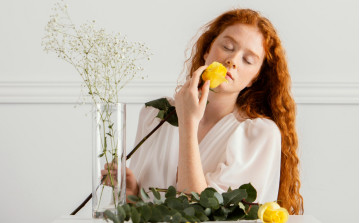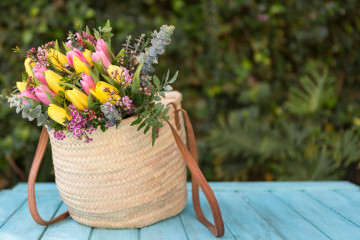Bouquet is: history of appearance and interesting facts
Bouquets as a gift have long been something traditional that we present to our loved ones and relatives for every holiday. However, when and why did this tradition begin? How did the first bouquet appear? To find out, you need to delve a little into history.
History of the flower bouquet: ancient times
Bouquet is a word of French origin, which literally means "bunch" or "bundle". The first products resembling bouquets were created in Ancient Egypt. Information about this was found in chronicles that describe compositions in the form of a torch. In them, flowers were arranged in tiers, after which the stems were tied with palm leaves. At that time, irises/lotuses/roses/poppies and a number of other flowers were traditional for flower arrangements.
As for floristry professionals, this profession first originated in Ancient Greece. Even at that time, both female and male compositions were created, and each type had its own special approach. Thus, female bouquets were much brighter and more colorful, while male ones usually consisted only of greenery. Intentionally growing flowers to create spectacular bouquets began in Ancient Rome.
In those distant times, the symbolism of buds was of colossal importance. Each bud carried its own special meaning, so their selection was approached very thoughtfully. For example, a rose was a symbol of love, and a lily flower reflected nobility and virtue. At the same time, not only the variety of plants was important, but also their shade. Some meanings have reached our days, which is why many people are interested in the topic of the language of flowers.
When talking about the history of bouquets, we cannot ignore China. In this country, flowers have always had enormous significance. However, in addition to their aesthetic appeal, they were of great benefit and were widely used in medicine. In general, fragrant buds have always been closely woven into the culture of China.
From the Middle Ages to the Present Day
Europe quickly adopted the significance of flowers, so already in the Middle Ages they were used in many religious ceremonies. In addition, they began to be widely used to convey various secret messages (including romantic ones). It was at this time that the language of flowers was actively formed.
During the Renaissance, floristry acquired a new meaning, as people became more interested in the spheres of science and art. Compositions at that time acquired new and very sophisticated forms. At the same time, new species of plants were constantly being discovered, which were also actively added to bouquets.
The apogee of the development of the language of flowers happened in the Victorian era. The transmission of messages was of particular importance then, because it was often impossible to talk about your feelings openly. The compositions of that time were very complex and included many flowers, each of which carried its own special meaning.
The development of new directions in art and design influenced the development of modern trends in floristry. Abstraction, minimalism, a combination of the incompatible, as well as various kinds of experiments became the norm when creating bouquets. This made it possible to achieve uniqueness for almost every composition. In the future, globalization inevitably led to a mixture of different cultures and styles, which could not affect flower bouquets. Modern compositions can contain elements of different cultures or even eras.
Current trends in floristry
Every year, the approach to creating flower arrangements changes, based on fashion trends, people's preferences and other aspects of life. Here are some popular trends of recent years:
- Environmental friendliness. Modern florists increasingly prefer plants grown without pesticides and other chemicals. In addition, local and seasonal flowers have become especially popular. The choice of packaging is no less important. Today, they try to use less plastic and other non-degradable materials.
- Naturalness and minimalism. Pomp and splendor are losing their positions, giving way to modern restrained elegance. At the same time, the severity of forms is often absent, and bouquets become more natural, as if collected with your own hands in the garden.
- Individuality. The world of the 21st century is increasingly striving for personalization, which cannot but affect floristry. They always try to add something special and unique to the composition, which would correspond to the tastes of a particular client. These can be certain flowers, decorative elements or souvenirs.
- Modern technologies. Technological progress could not but affect floristry. Thanks to the creation of the Internet and its global distribution, one of the most popular services has become flower delivery. As a result, the ideal composition can now be ordered without leaving home or even being on the other side of the world.
31-07-2025
Flowers for yourself31-07-2025
What flowers to give to girls30-06-2025
What flowers to give in summer












